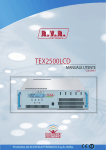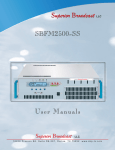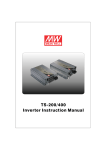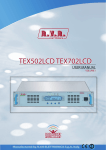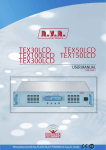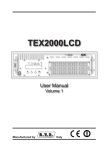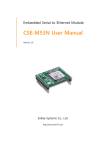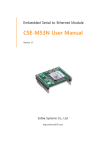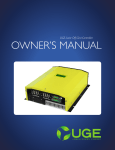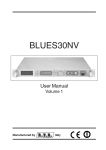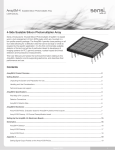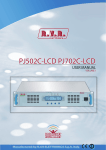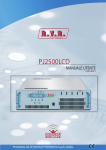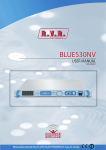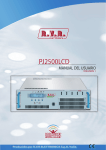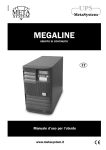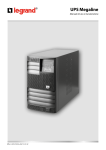Download TEX2500LCD - RVR Elettronica SpA Documentation Server
Transcript
TEX2500LCD USER MANUAL VOLUME1 Manufactured by R.V.R ELETTRONICA S.p.A. Italy File Name: TEX2500LCD_ING_1.0.indb Version: 1.0 Date: 27/09/2012 Revision History Date Version 27/09/2012 1.0 Reason First Version Editor J. H. Berti TEX2500LCD - User Manual Version 1.0 © Copyright 2012 R.V.R. Elettronica SpA Via del Fonditore 2/2c - 40138 - Bologna (Italia) Telephone: +39 051 6010506 Fax: +39 051 6011104 Email: [email protected] Web: www.rvr.it All rights reserved Printed and bound in Italy. No part of this manual may be reproduced, memorized or transmitted in any form or by any means, electronic or mechanic, including photocopying, recording or by any information storage and retrieval system, without written permission of the copyright owner. TEX2500LCD Table of Contents 1. 2. 3. 3.1 3.2 4. 4.1 4.2 4.3 4.4 4.5 4.6 5. 5.1 5.2 5.3 5.4 5.5 6. 6.1 6.2 7. 7.1 7.2 7.3 7.4 7.5 7.6 7.7 7.8 7.9 Preliminary Instructions Warranty First Aid Treatment of electrical shocks Treatment of electrical Burns General Description Unpacking Features Frontal Panel Description Rear Panel Description Connectors Pinouts Technical Description Quick guide for installation and use Preparation First power-on and setup Operation Management Firmware Optional functions Module identification Top view (TEX2500LCD) Bottom view (TEX2500LCD) Working Principles Power Supply Intercace Board Panel board Main Board Driver Board Power Amplifier LPF Board Bias Board External Telemetry Interface Board User Manual Rev. 1.0 - 27/09/12 1 1 2 2 2 3 3 3 5 6 7 9 10 10 11 14 16 21 24 24 25 26 26 27 28 28 29 29 29 30 30 TEX2500LCD This page was intentionally left blank ii Rev. 1.0 - 27/09/12 User Manual TEX2500LCD IMPORTANT The symbol of lightning inside a triangle placed on the product, evidences the operations for which is necessary gave it full attention to avoid risk of electric shocks. The symbol of exclamation mark inside a triangle placed on the product, informs the user about the presence of instructions inside the manual that accompanies the equipment, important for the efficacy and the maintenance (repairs). 1. Preliminary Instructions Operation of this equipment in a residential area may cause radio interference, in which case the user may be required to take adequate measures. • General Warnings The specifications and data contained herein are provided for information only and are subject to changes without prior notice. R.V.R. Elettronica S.p.A. disclaims all warranties, express or implied.While R.V.R. Elettronica S.p.A. attempts to provide accurate information, it cannot accept responsibility or liability for any errors or inaccuracies in this manual, including the products and the software described herein. R.V.R. Elettronica S.p.A. reserves the right to make changes to equipment design and/or specifications and to this manual at any time without prior notice. This equipment should only be operated, installed and maintained by “trained” or “qualified” personnel who are familiar with risks involved in working on electric and electronic circuits. “Trained” means personnel who have technical knowledge of equipment operation and who are responsible for their own safety and that of other unqualified personnel placed under their supervision when working on the equipment. “Qualified” means personnel who are trained in and experienced with equipment operation and who are responsible for their own safety and that of other unqualified personnel placed under their supervision when working on the equipment. WARNING: Residual voltage may be present inside the equipment even when the ON/OFF switch is set to Off. Before servicing the equipment, disconnect the power cord or switch off the main power panel and make sure the safety earth connection is connected. Some service situations may require inspecting the equipment with live circuits. Only trained and qualified personnel may work on the equipment live and shall be assisted by a trained person who shall keep ready to disconnect power supply at need. R.V.R. Elettronica S.p.A. shall not be liable for injury to persons or damage to property resulting from improper use or operation by trained/untrained and qualified/unqualified persons. WARNING: The equipment is not water resistant. Any water entering the enclosure might impair proper operation. To prevent the risk of electrical shock or fire, do not expose this equipment to rain, dripping or moisture. Please observe local codes and fire prevention rules when installing and operating this equipment. WARNING: This equipment contains exposed live parts involving an electrical shock hazard. Always disconnect power supply before removing any covers or other parts of the equipment. Ventilation slits and holes are provided to ensure reliable operation and prevent overheating; do not obstruct or cover these slits. Do not obstruct the ventilation slits under any circumstances. The product must not be incorporated in a rack unless adequate ventilation is provided or the manufacturer’s instructions are followed closely. WA R N I N G : T h i s e q u i p m e n t c a n r a d i a t e radiofrequency energy and, if not installed in compliance with manual instructions and applicable regulations, may cause interference with radio communications. WARNING: This equipment is fitted with earth connections both in the power cord and for the chassis. Make sure both are properly connected. User Manual • Notice concerning product intended purpose and use limitations. This product is a radio transmitter suitable for frequencymodulation audio radio broadcasting. Its operating frequencies are not harmonised in designated user countries. Before operating this equipment, user must obtain a licence to use radio spectrum from the competent authority in the designated user country. Operating frequency, transmitter power and other characteristics of the transmission system are subject to restrictions as specified in the licence. 2. Warranty La R.V.R. Elettronica S.p.A. warrants this product to be free from defects in workmanship and its proper operation subject to the limitations set forth in the supplied Terms and Conditions. Please read the Terms and Conditions carefully, as purchase of the product or acceptance of the order acknowledgement imply acceptance of the Terms and Conditions. For the latest updated terms and conditions, please visit our web site at WWW.RVR.IT. The web site may be modified, removed or updated for any reason whatsoever without prior notice. The warranty will become null and void in the event the product enclosure is opened, the product is physically damaged, is repaired by unauthorised persons or is used for purposes other than its intended use, as well as in the event of improper use, unauthorised changes or neglect. In the event a defect is found, follow this procedure: 1 Contact the seller or distributor who sold the equipment; provide a description of the problem or malfunction for the event a quick fix is available. Sellers and Distributors can provide the necessary information to troubleshoot the most frequently encountered problems. Normally, Sellers and Distributors can offer a faster repair service than the Manufacturer would. Please note that Sellers can pinpoint problems due to wrong installation. 2 If your Seller cannot help you, contact R.V.R. Elettronica S.p.A. and describe the problem; if our staff deems it appropriate, you will receive an authorisation to return the equipment along with suitable instructions; 3 When you have received the authorisation, you may return the unit. Pack the unit carefully before shipment; use the original packaging whenever possible and seal the package perfectly. The customer bears all risks of loss (i.e., R.V.R. shall not be liable for loss or damage) until the package reaches the R.V.R. factory. For this reason, we recommend insuring the goods for their full value. Returns must be sent on a C.I.F. basis (PREPAID) to the address stated on the authorisation as specified by the R.V.R. Service Manager. Rev. 1.0 - 28/09/12 / 30 TEX2500LCD Units returned without a return authorisation may be rejected and sent back to the sender. 4 Be sure to include a detailed report mentioning all problems you have found and copy of your original invoice (to show when the warranty period began) with the shipment. Please send spare and warranty replacement parts orders to the address provided below. Make sure to specify equipment model and serial number, as well as part description and quantity. 3.1.2 R.V.R. Elettronica S.p.A. Via del Fonditore, 2/2c 40138 BOLOGNA ITALY Tel. +39 051 6010506 3. First Aid All personnel engaged in equipment installation, operation and maintenance must be familiar with first aid procedures and routines. 3.1 Electric shock treatment 3.1.1 If the victim is unconscious Lay the victim down on his/her back on a firm surface. • the neck and tilt the head backwards to free Do not stop chest compressions while giving artificial breathing. • Call for medical help as soon as possible. If the victim is conscious • Cover victim with a blanket. • Try to reassure the victim. • Loosen the victim’s clothing and have him/her lie down. • Call for medical help as soon as possible. 3.2 Treatment of electric burns 3.2.1 Large burns and broken skin Follow the first aid procedures outlined below. • • • Cover affected area with a clean cloth or linen. • Do not break any blisters that have formed; remove any clothing or fabric that is stuck to the skin; apply adequate ointment. • Administer adequate treatment for the type of accident. • Get the victim to a hospital as quickly as possible. • Elevate arms and legs if injured. If medical help is not available within an hour, the victim is conscious and is not retching, administer a solution of table salt and baking soda (one teaspoon of table salt to half teaspoon of baking soda every 250 ml of water). the airway system (Figure 1). Have the victim slowly drink half a glass of solution for four times during a period of 15 minutes. Stop at the first sign of retching. Do not administer alcoholic beverages. Figure 1 • If needed, open the victim’s mouth and check for breathing. • If there is no breathing, start artificial respiration without delay (Figure 2) as follows: tilt the head backwards, pinch the nostrils, seal your mouth around the victim’s mouth and give four fast rescue breaths. 3.2.2 Minor burns • Apply cold (not ice cold) strips of gauze or dress wound with clean cloth. • Do not break any blisters that have formed; remove any clothing or fabric that is stuck to the skin; apply adequate ointment. • If needed, have the victim change into clean, dry clothing. • Administer adequate treatment for the type of accident. • Get the victim to a hospital as quickly as possible. • Elevate arms and legs if injured. Figure 2 • / 30 Check for heartbeat (Figure 3); if there is no heartbeat, begin chest compressions immediately (Figure 4) placing your hands in the centre of the victim’s chest (Figure 5). Figure 3 Figure 4 Figure 5 • One rescuer: give 2 quick rescue breaths after each 15 compressions. • Two rescuers: one rescue breath after each 5 compressions. Rev. 1.0 - 28/09/12 User Manual TEX2500LCD 4. General Description TEX2500LCD is a compact FM transmitter manufactured by R.V.R. Elettronica SpA for audio radio broadcasting in the 87.5 to 108 MHz band in 10kHz steps, featuring adjustable RF output up to 2500 W, respectively, under 50 Ohm standard load. TEX2500LCD is designed to being contained into a 19” rack box of 3HE. 4.1 Unpacking The package contains: 1 TEX2500LCD 1 User Manual 1 Mains power cables The following accessories are also available from Your R.V.R. Dealer: • Accessories, spare parts and cables 4.2 Features The overall efficiency of TEX2500LCD is better than 70% across the bandwidth, for this reason are part of RVR Green Line family. This performance characteristic is guaranteed in a range between +0.25 dB and -3 dB (+5% and -50%) referred to the nominal power of the equipment: for example from 1250W to 2625W in case of TEX2500LCD; outside these limits the equipment is able to work properly but can not guarantee an efficiency of 68%. This transmitter incorporate a low-pass filter to keep harmonics below the limits provided for by international standards (CCIR, FCC or ETSI) and can be connected directly to the antenna. Two major features of TEX2500LCD is compact design and user-friendliness. Another key feature is its modular-concept design: the different functions are performed by modules with most connections achieved through male and female connectors or through flat cables terminated by connectors. This design facilitates maintenance and module replacement. The RF power section of TEX2500LCD uses four LD-MOSFET modules delivering up to 800W output power each. User Manual Rev. 1.0 - 28/09/12 / 30 TEX2500LCD Operating frequency stability is ensured by a temperature-compensated reference oscillator and is maintained by a PLL (Phase Locked Loop) system. The transmitter will go into frequency lock within 30 seconds after power-on. TEX2500LCD can operate throughout the frequency bank with no need for calibration or set-up. An LCD on the front panel and a push-button panel provide for user interfacing with the microprocessor control system, which implements the following features: • Output power setup. • Working frequency setup. • Power output enable/disable. • User-selectable threshold settings for output power alarm (Power Good feature) • Measurement and display of exciter operating parameters. • Communication with external devices such as programming or telemetry systems via RS232 serial interface or I2C. Four LEDs on the front panel provide the following status indications: ON, LOCK, FOLDBACK and RF MUTE. The exciter management firmware is based on a menu system. User has four navigation buttons available to browse submenus: ESC , , , ed ENTER. The rear panel features the mains input connectors, as well as audio input connectors and RF output connector, telemetry connector, protection fuses and two inputs for signals modulated onto subcarriers by suitable external coders, such as RDS (Radio Data System) signals commonly used in Europe. / 30 Rev. 1.0 - 28/09/12 User Manual TEX2500LCD 4.3 Frontal Panel Description Figure 6.1 [1] ON [2] LOCK [3] FOLDBACK [4] R.F. MUTE [5] CONTRAST [6] ESC [7] [8] [9] ENTER [10] DISPLAY [11] POWER [12] AIR FLOW [13] ALARMS PS1 [14] ALARMS PS2 User Manual Green LED - Turns on when exciter is powered on. Green LED verde - Turns on when PLL is locked to operating frequency. Yellow LED - Turns on when foldback current limiting (Automatic Gain Control) kicks in. Yellow LED - Turns on when exciter power output is inhibited by an external interlock signal. Display contrast trimmer. Press this button to exit a menu. Navigation button used to browse menu system and edit parameters. Navigation button used to browse menu system and edit parameters. Press this button to confirm a modified parameter and open a menu. Liquid Crystal Display. ON/OFF key. Air grille. Yellow LED - Turns on when Power Supply unit is not fed either because “PWR OFF” was selected via software, or power is set to 0 W, or due to Power Supply malfunction (when this LED turns on, it causes the ALARM PS2 LED to come on as well, because the two LEDs are connected internally). Yellow LED, see item [13]. Rev. 1.0 - 28/09/12 / 30 TEX2500LCD 4.4 Rear Panel Description [1] R.F. TEST [2] [3] [4] [5] [6] [7] [8] GSM SLOT-IN GSM ANT AIR FLOW 10MHz PILOT ADJ PHASE ADJ 19 kHz PILOT OUT [9] PREEMPHASIS [10]MODE/MPX IMP [11]SCA2 [12]SCA1 [13]MPX [14]SCA2 ADJ [15]MPX ADJ [16]SCA1 ADJ [17]RIGHT ADJ [18]RIGHT [19]IMPEDANCE [20]MAINS [21] FUSE 1 [22]10MHz [23]R.F. OUTPUT [24]INTERLOCK OUT [25]SERVICE [26]INTERLOCK IN [27]FWD EXT. AGC [28]RFL EXT. AGC [29]MODEM [30]REMOTE / 30 Figure 6.2 Output with level -60 dB lower than output power level, suitable for modulation monitoring. Not suitable for spectrum analysis. Reserved for future implementations. Reserved for future implementations. Air grille. Reserved for future implementations. Pilot tone trimmer. Phase trimmer. Tone output BNC connector, may be used to synchronise external devices such as RDS coders. Preemphasis dip-switch, provides two settings: 50 or 75 μs. Preemphasis affects the right and left inputs in stereo mode and the mono input. MPX inputs are not affected by preemphasis setting. Dip-switch used to select transmission mode (STEREO or MONO) and MPX input impedance (50 Ω or 10 kΩ). BNC connector for SCA2 input. BNC connector for SCA1 input. Unbalanced MPX input BNC connector. Trimmer for SCA2 input level adjustment. Trimmer for MPX input level adjustment. Trimmer for SCA1 input level adjustment. Trimmer for right input level adjustment. Right audio channel input XLR connector. Dip-switch used to select balanced audio input impedance (600 Ω or 10 kΩ). Connectors for 230 V (+/- 15%) 50-60 Hz mains power supply. Mains power supply fuse. Reserved for future implementations. RF output connector, 7/8”. Interlock output BNC connector: when the transmitter goes into stand-by mode, the (normally floating) central conductor is switched to ground. DB9 connector for factory setting. Interlock input BNC connector: the exciter is forced in standby mode when the inner conductor is grounded. Trimmer to set output power limitation according to FWD fold input. Trimmer to set output power limitation according to RFL fold input. Reserved for future implementations. DB15 telemetry connector. Rev. 1.0 - 28/09/12 User Manual TEX2500LCD [31]RS232 [32]I2C BUS [33]LEFT ADJ [34]LEFT [35] FUSE 2 Reserved for future implementations. Reserved for future implementations. Trimmer for left input level adjustment. Left audio channel input XLR connector. Mains power supply fuse. 4.5 Connector Pinouts 4.5.1 RS232 Type: Female DB9 1 2 3 4 5 6 7 8 9 NC SDA SCL NC GND NC NC NC NC 4.5.2 Service (for factory setting) Type: Female DB9 1 2 3 4 5 6 7 8 9 NC TX_D RX_D Internally connected to 6 GND Internally connected to 4 Internally connected to 8 Internally connected to 7 NC 4.5.3 Left (MONO) / Right Type: Female XLR 1 2 3 User Manual GND Positive Negative Rev. 1.0 - 28/09/12 / 30 TEX2500LCD 4.3.4 Remote Type: Female DB15 Pin Name Type 1 Interlock IN 2 Ext AGC FWD IN 3 GND 4 SDA IIC I/O 5 VPA Tlm ANL OUT 6 FWD Tlm ANL OUT 7 Power Good DIG OUT 8 GND 9 GND 10 Ext AGC RFL IN 11 SCL IIC I/O 12 IPA Tlm ANL OUT 13 RFL Tlm ANL OUT 14 On cmd DIG IN 15 OFF cmd DIG IN / 30 Rev. 1.0 - 28/09/12 Purpose Inhibits power if closed to GND Ext. signal,1-12V, for limitation (AGC) Ground Serial data for IIC communication PA supply voltage: 3.9V F.S. Forward power: 3.9V F.S. Indicates activation by switching the normally-open contact to ground (sect. 5.4.1). Ground Ground Ext. signal,1-12V, for limitation (AGC) Clock for IIC communication PA supply current: 3.9V F.S. Reflected power: 3.9V F.S. A pulse towards ground (500 ms) triggers power output A pulse towards ground (500 ms) inhibits power output User Manual TEX2500LCD 4.6 Technical Description TEX2500LCD Parameters Conditions GENERALS Frequency range Rated output power Modulation type Operational Mode AC Supply Voltage DC Supply Voltage Active Power Consumption Overall Efficiency Input device Display Phisical Dimensions Ambient working temperature Frequency programmability Frequency stability Modulation capability Pre-emphasis mode Spurious & harmonic suppression Asynchronous AM S/N ratio Synchronous AM S/N ratio MONO OPERATION S/N FM Ratio Frequency Response Total Harmonic Distortion Intermodulation distortion Transient intermodulation distortion MPX OPERATION Composite S/N FM Ratio Frequency Response Total Harmonic Distortion Intermodulation distortion Transient intermodulation distortion Stereo separation STEREO OPERATION Stereo S/N FM Ratio Frequency Response Total Harmonic Distortion Intermodulation distortion Transient intermodulation distortion Stereo separation Main / Sub Ratio SCA OPERATION Frequency response Crosstalk to main or to stereo channel AUDIO INPUTS MPX balanced/Left Right MPX unbalanced/RDS SCA/RDS OUTPUTS RF Output RF Monitor Pilot output MPX Monitor AUXILIARY CONNECTIONS Interlock Service Remote Interface POWER REQUIREMENTS AC Power Input DC Power Input Mains input voltage range Backup Input Voltage Weigh TELEMETRY / TELECONTROL Remote connector inputs Remote connector outputs Value MHz W 87.5 ÷ 108 2500 Direct carrier frequency modulation Mono, Stereo, Multiplex 230 ±15% VAC VDC W % Front panel width Front panel height Overall depth mm HE mm °C WT from -10°C to 50°C Referred to 100% AM, with no de-emphasis Referred to 100% AM, FM deviation 75 kHz by 400Hz sine, without de-emphasis ppm kHz μS dBc dB dB 3571 Typical 70 4 pushbutton Alphanumerical LCD - 2 x 16 483 3 675 -10 to + 50 From software, with 10 kHz steps ±1 150 Stereo, 180 Mono/MPX 0, 50 (CCIR), 75 (FCC) <75 (80 typical) ≥ 65 (typical 70) ≥ 50 (typical 60) RMS @ ± 75 kHz peak, HPF 20Hz - LPF 23 kHz, 50 μS de-emphasis Qpk @ ± 75 kHz peak, CCIR weighted, 50 μS de-emphasis Qpk @ ± 40 kHz peak, CCIR weighted, 50 μS de-emphasis 30Hz ÷ 15kHz THD+N 30Hz ÷ 15kHz Measured with a 1 KHz and 1.3 KHz tones, 1:1ratio, at FM 75 kHz Measured with a 3.18 kHz square wave and a 15 kHz sine wave at 75 kHz FM dB dB dB dB % % % > 78 (typical 83) >70 >67 better than ± 0.5 dB (typical ± 0.2) < 0.1 (Typical 0.07%) < 0.02 < 0.1 (typical 0.05) RMS @ ± 75 kHz peak, HPF 20Hz - no LPF, 50 μS de-emphasis 30Hz ÷ 53kHz 53kHz ÷ 100kHz THD+N 30Hz ÷ 53kHz THD+N 53kHz ÷ 100kHz Measured with a 1 KHz and 1.3 KHz tones, 1:1, modulation at FM 75 kHz Measured with a 3.18 kHz square wave and a 15 kHz sine wave at 75 kHz FM 30Hz ÷ 53kHz dB dB dB % % % % dB > 78 (typical 83) ± 0.2 ± 0.5 < 0.1 < 0.15 < 0.05 < 0.1 (typical 0.05) > 50 dB (typical 60) RMS @ ± 75 kHz peak, HPF 20Hz - LPF 23 kHz, 50 μS de-emphasis, L & R demodulated dB > 73 (75 typical) Qpk @ ± 75 kHz peak, CCIR weighted, 50 μS de-emphasis, L & R demodulated Qpk @ ± 40 kHz peak, CCIR weighted, 50 μS de-emphasis, L & R demodulated 30Hz ÷ 15kHz THD+N 30Hz ÷ 15kHz Measured with 1 KHz and 1.3 KHz tones, 1:1 ratio, modulation at FM 75 kHz Measured with a 3.18 kHz square wave and a 15 kHz sine wave at 75 kHz FM 30Hz ÷ 15kHz dB dB dB % % % dB dB > 65 dB > 58 dB ± 0.5 < 0.05 ≤ 0.03 < 0.1 (typical 0.05) > 50 (typical 55) > 40 (typical 45) 40kHz ÷ 100kHz RMS, ref @ ± 75 kHz peak, no HPF/LPF, 0μS de-emphasis, with 67 kHz tone on SCA input @ 7,5kHz FM deviation RMS, ref @ ± 75 kHz peak, no HPF/LPF, 0μS de-emphasis, with 92 kHz tone on SCA input @ 7,5kHz FM deviation dB dB dB ± 0.5 > 75 (typical 78 ) > 78 (typical 80 ) Connector Type Impedance Input Level /Adjust Connector Type Impedance Input Level Connector Type Impedance Input Level / Adjust Connector Type Impedance Input Level / Adjust Connector Impedance Connector Impedance Output Level Connector Impedance Output Level Connector Impedance Output Level Ohm dBu dB dB Ohm dBu dB dB Ohm dBu dB dB Ohm dBu dB dB Ohm Ohm dB Ohm Vpp AC Supply Voltage AC Apparent Power Consumption Active Power Consumption Power Factor Connector DC Supply Voltage DC Current XLR F balanced or externally unbalanced 10 k or 600 -13 to +13 XLR F balanced or externally unbalanced 10 k or 600 -13 to +13 BNC unbalanced 10 k or 50 *-13 to +13 2 x BNC unbalanced 10 k *-8 to +13 7/8" EIA 50 BNC 50 approx. -60 BNC >5 k 1 Ohm dBu Connector Connector Connector FUSES On Mains On services On PA Supply On Driver Supply MECHANICAL DIMENSIONS Phisical Dimensions U.M. 2 x BNC DB9 F DB15F VAC VA W 230 ±15% 3578 3571 0,998 Terminal Block VDC ADC 2 External fuse F 25 T - 10 x 38 mm 1 External fuse F 3.15 T - 5x20 mm 4 Internal fuses F 25 A 10 x 38 mm Overall depth mm mm mm Chassis depth mm 650 kg about 31 Front panel width Front panel height Analogical level Analogical level pulse pulse ON/OFF level Analogical level Analogical level Analogical level Analogical level ON / OFF level 483 (19") 132 (3HE) 675 FWD fold REF fold RF ON RF OFF Interlock FWD REF VPA IPA Power Good I2Cbus Remote connector others VARIOUS Cooling Acoustic Noise User Manual dBA Rev. 1.0 - 28/09/12 Forced, with internal fan <75 / 30 TEX2500LCD 5. Quick guide for installation and use This section provides a step-by-step description of equipment installation and configuration procedure. Follow these procedures closely upon first power-on and each time any change is made to general configuration, such as when a new transmission station is added or the equipment is replaced. Once the desired configuration has been set up, no more settings are required for normal operation; at each power-up (even after an accidental shutdown), the equipment defaults to the parameters set during the initial configuration procedure. The topics covered in this section are discussed at greater length in the next sections, with detailed descriptions of all hardware and firmware features and capabilities. Please see the relevant sections for additional details. IMPORTANT: When configuring and testing the transmitter in which the equipment is integrated, be sure to have the Final Test Table supplied with the equipment ready at hand throughout the whole procedure; the Final Test Table lists all operating parameters as set and tested at the factory. 5.1 Preparation 5.1.1 Preliminary checks Unpack the exciter and immediately inspect it for transport damage. Ensure that all connectors are in perfect condition. The main fuse can be accessed from the outside on the rear panel. Extract the fuse carrier with a screwdriver to check its integrity or for replacement, if necessary. The following fuses are used: TEX2500LCD @ 230 Vac Main power supply (2x) 25A type 10x38 Service power supply (1x)3.15A type 5x20 (fig. 6.2 – items [20] and [35]) ( fig. 6.2 – item [32]) Table 5.1: Fuse The mains power supply unit is the full-range type and requires no voltage setup. Provide for the following (applicable to operating tests and putting into service): √ Single-phase 230 (-15% / +10%) Vac mains power supply, with adequate earth connection. 10 / 30 Rev. 1.0 - 28/09/12 User Manual TEX2500LCD √ For operating tests only: dummy load with 50 Ohm impedance and adequate capacity (2500W for TEX2500LCD as a minimum). √ Connection cable kit including: • Mains power cable. • Coaxial cable with BNC connectors for interlock signal connection between exciter and amplifier. • RF cable for output to load / antenna (50 Ohm coaxial cable with standard 7/8” connector). • Audio cables between transmitter and audio sources. 5.1.2 Connections Connect the RF output of the transmitter to the antenna cable or a dummy load capable of dissipating exciter output power. To begin with, set exciter to minimum output power and switch it off. Connect the transmitter INTERLOCK IN input to the matching INTERLOCK OUT output fitted on R.V.R. Elettronica equipment to act as hybrid couplers. If your equipment is a different brand, identify an equivalent output. WARNING: Electric shock hazard! Never handle the RF output connector when the equipment is powered on and no load is connected. Injury or death may result. Ensure that the POWER switch on the front panel is set to “OFF”. Connect the mains power cable to the MAINS connector on the rear panel. Note : The mains must be equipped with adequate ground connection properly connected to the machine. This is a pre-requisite for ensuring operator safety and correct operation. 5.2 First power-on and setup Perform this procedure upon first power-up and each time you make changes to the configuration of the transmitter this component is integrated into. Note : Standard factory settings are RF output power on (Pwr ON) and regulated output power set to lower limit (unless otherwise specified by customer). 5.2.1 Power-on When you have performed all of the connections described in the previous paragraph, power on the exciter using the suitable power switch on the front panel. User Manual Rev. 1.0 - 28/09/12 11 / 30 TEX2500LCD 5.2.2 Power check Ensure that the ON LED turns on. Forward power and modulation readings should appear briefly on the display. If the RF output is disabled, those readings will be zero. When the PLL locks to operating frequency, the LOCK LED will turn on. 5.2.3 How to enable the RF output Check output power level and set it to maximum level (unless it has already been set) from the Power Setup menu that you will have accessed by pressing the following sequence of key: ESC (opens Default Menu) ⇒ ENTER (hold down for 2 seconds) ⇒ SET ⇒ use keys to set bar to upper limit. 5.2.4 Output power level control IMPORTANT: The exciter incorporates Automatic Gain Control (AGC) and output power is modulated based on the power level set by the user and actual operating conditions, such as temperature, reflected power and other parameters. Please read section 5.3 for more details of RF power modulation. Access the Power Setup Menu pressing the following keys in the order: ESC (opens Default Menu) ⇒ ENTER (hold down for 2 seconds). Use the keys and in the SET menu to set exciter output power; the setting bar at the side of SET provides a graphic indication of power setting; please consider that the forward power readout provided on the display (FWD: xxxx W) reflects actual output power reading, which may be lower than regulated power supply when Automatic Gain Control is running in power supply limitation mode (please read section 5.3 about RF power supply modulation for more details). Note : Output power may be set using the Pwr OFF control. In this condition, the output power readout (Fwd) on the display will read 0 (zero); the SET bar will reflect any adjustments you make using the keys and provides a graphic indication of how much power supply will be delivered the moment you return to Pwr On state. 5.2.5 Changing the Power Good alarm threshold Change Forward Power Good alarm setting PgD from the Fnc menu as desired (factory setting is 50%). Please read section 5.4.1 for more details. 12 / 30 Rev. 1.0 - 28/09/12 User Manual TEX2500LCD 5.2.6 Setting equipment I2C address Change the IIC address in the MIX (Miscellaneous) menu as desired (factory setting is 01). Please read section 5.4.1 for more details. 5.2.7 Adjustments and calibration The only manual adjustments are the level adjustments and the audio mode adjustment. The rear panel holds the trimmers for all exciter inputs. Trimmer identification is printed on the rear panel. Input sensitivity can be set within the limits set out in the tables below through the trimmers: Input sensitivity in Mono mode: Input SCA1 SCA2 MPX Mono Figure 6.2 [11] [10] [12] [34] Trimmer [15] [13] [14] [33] Sensitivity - 8 ÷ +13 dBm - 8 ÷ +13 dBm -13 ÷ +13 dBm -13 ÷ +13 dBm Note Input level for 7,5 kHz deviation (-20 dB) Input level for 75 kHz deviation (0 dB) Input sensitivity in Stereo mode: Input MPX SCA1 SCA2 Left Right Figure 6.2 [12] [11] [10] [34] [17] Trimmer [14] [15] [13] [33] [16] Sensitivity -20 ÷ +13 dBm - 8 ÷ +13 dBm - 8 ÷ +13 dBm -13 ÷ +13 dBm -13 ÷ +13 dBm Note Input level for 75 kHz deviation (0 dB) Input level for 7,5 kHz deviation (-20 dB) Input level for 75 kHz deviation (0 dB) When setting input sensitivity, please consider that the default menu reports instantaneous modulation level and an indicator provides a 75 kHz reading. To ensure correct adjustment, apply a signal with the same level as user’s audio broadcast maximum level and then adjust using the trimmer until instantaneous deviation matches the 75 kHz reading. To set subcarrier input levels, you may use the same procedure and option “x10” available in the Fnc menu. With this option, modulation level is multiplied by a factor of 10, which means that default menu bar meter reflects a 7.5 kHz deviation. A special menu with separate indications of Left and Right channel levels and relating indicators of nominal levels for maximum deviation (75 kHz) is provided. • Preemphasis: ON 1 ON 2 3 4 User Manual 50 ms 1 2 3 4 75 ms Rev. 1.0 - 28/09/12 13 / 30 TEX2500LCD • L and R (XLR type) input impedance: ON 1 Switch 1: R XLR input impedance, ON = 600 W, OFF = 10 kW 2 Switch 2: L XLR input impedance, ON = 600 W, OFF = 10 kW • MPX input operation mode/impedance: ON 1 Switch 1: Mode of operation ON = Mono, OFF = Stereo 2 Switch 2: MPX input impedance, ON = 50 W, OFF = 10 kW 5.3 Operation 1) Power on the exciter and ensure that the ON light turns on. Forward and reflected power readings (Menu 1) should appear briefly on the display, provided that the exciter is delivering output power. Menù 1 1b) To modify power level setting, hold down the ENTER button until opening the power setup menu. The edit screen will look like this: Menù 2 Next to SET indication, a bar provides a graphic display of preset output power. The filled portion of the bar is proportional to set power level. Example ≅ 110/120% of nominal power 100% output power 14 / 30 Rev. 1.0 - 28/09/12 Full bar ≅ 2525/2550 W in output (mod.TEX2500LCD) User Manual TEX2500LCD ≅ 75% of nominal power 50% output power Half bar ≅ 1875W in output (mod.TEX2500LCD) ≅ 40% of nominal power 25% output power 1/4 bar ≅ 1000W in output (mod.TEX2500LCD) The bottom line provides instantaneous power reading (in this example 2.47kW, falling below 1.6kW the reading back to Watt. As result of hysteresis power up , exceeding 1400W the reading back to kWatt); press button to increase level, press to decrease it. When you have achieved the desired level, press ENTER to confirm and exit the default menu. Please note that the setting is stored automatically; in other words, if you press ESC or do not press any keys before the preset time times out, the latest power level set will be retained. NOTE: This feature prevents the machine from delivering maximum power as soon as output is enabled from menu 4, or in the event the machine is already set to ON and energised. 2) Ensure that machine is not in a locked-out state. Press the ESC key to call up the selection screen (Menu 3). Highlight Fnc and press ENTER to confirm and access the appropriate menu (menu 4). In the same menu, ensure that power limiting is disabled: if PWR is set to OFF, i.e. power output is disabled, move cursor to PWR. Press ENTER and label will switch to ON, i.e. power output enabled. Press ESC twice to go back to the default menu (menu 1). 3) Fine tune power setting from menu 2 (see description of item 1b) until achieving the desired value. WARNING: Machine is capable of delivering more than rated output power (2500 W); however, never exceed the specified power rating. NOTE: If power is set to 0 W in the Power Setup Menu, the INTERLOCK OUT contact is activated and any external appliances connected to it are immediately inhibited. Next, you can review all operating parameters of the machine through the management firmware. Normally, the machine can run unattended. Any alarm condition is handled automatically by the safety system or is signalled by the LED indicators on the panel or by display messages. NOTE: Standard factory settings are: output power set to upper limit (unless otherwise specified by customer) and OFF. User Manual Rev. 1.0 - 28/09/12 15 / 30 TEX2500LCD 5.4 Management Firmware The machine features an LCD with two lines by 16 characters that displays a set of menus. Figure 5.2 below provides an overview of machine menus. The symbols listed below appear in the left portion of the display as appropriate: (Cursor) - Highlights selected (i.e. accessible) menu. (Filled arrow) - Editable parameter marker. This symbol appears in menus that take up more than two lines to aid browsing. (Three empty arrows) - Parameter is being edited. (Empty arrow) - Current line marker; the parameter in this line cannot be edited. This symbol appears in menus that take up more than two lines to aid browsing. Menu 2 Menu 1 Predefined menu Power Adjustment Menu Menu 3 Selection Menu Menu 4 Operation Menu Menu 5 Power Menu Menu 6 Power Amplifier Menu Menu 7 Settings Menu Menu Miscellaneous Menu Menu Versions Menu Menu 10 Channels Menu Figure 5.2 When the display is off, touching any key will turn on backlighting. 16 / 30 Rev. 1.0 - 28/09/12 User Manual TEX2500LCD When the display is on, pressing the ESC button from the default menu (menu 1) calls up the selection screen (menu 3), which gives access to all other menus: Menu 3 If the temperature alarm is enabled and the alarm threshold is exceeded, the following screen will be displayed (only if you are in the default screen): State 1 As soon as operating conditions are restored, power output is re-enabled with the same settings in use prior to the alarm condition. Under 20kHz, no modulation occurs. After a preset time of about 5 minutes (not editable), a NO AUDIO condition is indicated in the main screen, but power is not inhibited. State 2 To gain access to a submenu, select menu name (name is highlighted by cursor) using button or and press the ENTER button. To return to the default menu (menu 1), simply press ESC again. 5.4.1 Operation Menu (Fnc) In this menu, you can toggle exciter power output On/Off, set deviation display mode and the threshold rate for Forward (PgD) or Reflected (PgR) Power Good. User Manual Rev. 1.0 - 28/09/12 17 / 30 TEX2500LCD To edit an item, highlight the appropriate line using the and buttons and then press and hold the ENTER button until the command is accepted. This way, Pwr setting is toggled between On and Off and Mod setting is toggled between “x1” and “x10”. To edit the Power Good rate, simply select item “PgD” or “PgR” and edit its value using the UP and DOWN buttons; finally, press ENTER to confirm. Menu 4 Pwr 18 / 30 Enables (ON) or disables (OFF) exciter power output. Mod Modifies modulation display (toggles between “x1” and “x10”). In “x10” mode, instantaneous deviation indication is multiplied by a factor of 10, and the bar meter on the default menu will reflect 7.5 kHz instead of 75 kHz. This display mode is convenient when you wish to display low deviation levels, such as those caused by pilot tone or subcarriers. PgD Modifies Power Good threshold for forward power. The Power Good rate is a percent of equipment rated power (2500W for TEX2500LCD), not of forward output power. This means that this threshold set at 50% will give 1250 W, respectively, regardless of set power level. The Power Good feature enables output power control and reporting. When output power drops below set Power Good threshold, the equipment changes the state of pin [7] of the DB15 “Remote” connector located on the rear panel. PgR Modifies Power Good threshold for reflected power. The Power Good rate is a percent of equipment rated power (250W for TEX2500LCD), not of reflected output power. This means that this threshold set at 4%, respectively, will give 10W regardless of set power level. The Power Good feature enables output power control and alarm management. NOTE: This alarm does not trip any contacts in the DB15 “Remote” connector and is only available in systems equipped with telemetry. Rev. 1.0 - 28/09/12 User Manual TEX2500LCD 5.4.2 Power Menu (Pwr) This screen holds all readings related to equipment output power: Menù 5 Fwd Rfl Forward power reading. Reflected power reading. Note that these are readings, rather than settings, and cannot be edited (note the empty triangle). To change power setting, go to the default menu as outlined earlier. 5.4.3 Power Amplifier (P.A) Menu This screen is made up of four lines that can be scrolled using the buttons and shows the readings relating to final power stage: and Menu 6 Note that these are readings, rather than settings, and cannot be edited (note the empty arrow). VPA Voltage supplied by amplifier module. Eff Efficiency based on ratio of forward power to amplifier module power, in percent ( FWD PWR/(Vpa x Ipa) % ). Tmp Equipment internal temperature reading. IPA User Manual Current draw of amplifier module. Rev. 1.0 - 28/09/12 19 / 30 TEX2500LCD 5.4.4 Setup Menu (Set) This menu lets you view and set operating frequency. Menu 7 F1 Operating frequency setup. Set a new frequency value and then press the ENTER button to confirm your selection; the exciter unlocks from current frequency (the LOCK LED turns off) and will lock to the new operating frequency (LOCK turns back on again). If you press ESC or let the preset time time out, the previous frequency setting is retained. 5.4.5 Miscellaneous Menu (Mix) This menu lets you set equipment address in an I2C bus serial connection: Menu 8 IIC I2C address setting. The I2C network address becomes significant when the exciter is connected in an RVR transmission system that uses this protocol. Do not change it unless strictly required. 5.4.6 Version Menu (Vrs) This screen holds equipment version/release information: Menu 9 Note that these are readings, rather than settings, and cannot be edited (note the empty arrow) Rel Dat Tab 20 / 30 Firmware release information. Release date. Shows table loaded in the memory. Rev. 1.0 - 28/09/12 User Manual TEX2500LCD 5.4.7 Channels Menu (L&R) Right and left channel input levels are displayed as horizontal bars as shown in the figure below. The bar meter reflects the level corresponding to a 100% deviation for each channel and provides a convenient reference when setting audio channel input levels. Menu 10 L R Left channel Vmeter. Right channel Vmeter. 5.5 Optional functions A range of options is available for the product to add certain functions and/or modify existing functions. Outlined below are the functions available at the moment, which must be specified on order. 5.5.1 FSK option The FSK function generates periodic carrier frequency shifts to generate a Morsecoded station ID code. NOTE: This function is typically used in the USA. The factory setting for frequency shift amplitude is +10KHz and code repetition period is 60 minutes (please contact R.V.R. Elettronica if you need different settings), whereas station identified may be programmed by the user following the indications provided in section 5.5.1.1. When the FSK option is fitted, an FSK submenu is added to the selection menu. Menu 11 Press the ENTER key when FSK is highlighted in the selection menu to access the FSK submenu: User Manual Rev. 1.0 - 28/09/12 21 / 30 TEX2500LCD Menu 12 FSK Enables / disables FSK code transmission. Cod Shows the Morse code sent normally. 5.5.1.1 Changing the ID code User may change the FSK code used as a station identifier at any time. This procedure requires: • 1 RS232 male-female cable; • Hyper Terminal interface (make sure it has been installed together with Windows®) or equivalent serial communication software A brief description of the procedure is provided below: • Connect the PC serial port COM to the SERVICE connector on the rear panel of TEX2500LCD using a standard Male DB9 - Female DB9 serial cable. • Power on the exciter; • Launch the serial communication software; • Set communication parameters as follows: Baud Rate: 19200 Data Bit: 8 Parity: None Stop Bit: 1 Flow control: None; • Activate Caps-Lock through the communication software and send string CODE followed by the 6-character station ID code followed by Enter. NOTE: To be treated as valid, the code must be made up of 6 alphanumeric characters and must contain no blank spaces; if acknowledged as valid, code is echoed back to the terminal, illegal codes are not echoed. 5.5.2 Power UP/DOWN Option The Power UP/DOWN option modifies the signal receive function for the signals present at the telemetry connector. 22 / 30 Rev. 1.0 - 28/09/12 User Manual TEX2500LCD RF section on / off control signals are treated as control signals for RF output power level to allow for UP/DOWN setting. The UP or DOWN command is provided by switching the corresponding signal at the connector to ground for at least 500mS (pin features internal pull-up to power supply). Configuration of DB15F telemetry connector (Remote): Pin Standard function Power UP/DOWN function 14 On cmd Up cmd Increases RF output power Enables RF output power 15 Off cmd User Manual Down cmd Disables RF output powerDecreases RF output power Rev. 1.0 - 28/09/12 23 / 30 TEX2500LCD 6. Module identification TEX2500LCD is made up of several modules connected through connectors to facilitate maintenance and replacement (if needed). 6.1 Top view (TEX2500LCD) The figure below shows a top view of the equipment and component locations. Figure 6.1 [1] BIAS board [2] Low-pass filter board [3] PS Filter board [4] Panel board [5] FAN1 [6] Power supply units [7] Power Factor [8] Surge Protection board [9] Main Board [10]FAN2 [11] Driver Board & Temperature Measure Board [12]Splitter board [13]RF modules [14]Fuse board 24 / 30 Rev. 1.0 - 28/09/12 User Manual TEX2500LCD 6.2 Bottom view (TEX2500LCD) Figure 6.2 below shows a bottom view of the equipment and component locations. Figure 6.2 [1] [2] [3] [4] [5] [6] FAN2 Telemetry board Surge Protection board Service Power supply Interface board PS LED board User Manual Rev. 1.0 - 28/09/12 25 / 30 TEX2500LCD 7. Working Principles The figures below provide an overview of TEX2500LCD (fig. 7.1) modules and connections. R.F. VPA(46VDC) R.F. INPUT (AUDIO/RDS) 4XR.F. 4XR.F. SPLITTER DRIVER RFMODULES LPF+ DIRECT.COUPL. R.F. OUTPUT BIAS 4XVPA(46VDC) MAINBOARD R.F. COMBINER FUSEBOARD FWDPWR RFLPWR 4XVPA(46VDC) BIAS VOLTAGEREG. MAINS INTERFACE 4X46VDC PSALARM DC SURGE PROT. PFC POWERSUPPLY PANEL LEDCARD TELEMETRY INTERFACE Figura 7.1 Following is a brief description of the different module functions; all diagrams and board layout diagrams are included in the “Technical Schedule” Vol.2. 7.1 Power supply The TEX2500LCD power supply sections is made up of a surge protection module and two power supply units: 1. Surge Protection: Surge Protection board protects machine from eventual unexpected variations of the mains voltage. 2. Service: This section contains elements that do not regard directly the power supply, they are:: - Service transformer - Power switch - Service fuse 2. Power supply: various units supplies an adapted supply to RF power amplifier modules. The units that compose power supply are rectifier (PFC) and switching power supplies. 26 / 30 Rev. 1.0 - 28/09/12 User Manual TEX2500LCD 7.1.1 Mains power supply surge protection This module is enclosed in a sealed metal case; it features two externally mounted mains fuses and accommodates a bank of surge arresters that protect the machine from any surge events in the power mains. Mains voltage is brought from this module to the main Power switch on the front panel, which relays it to the service power supply. Inside the surge protection module, a suitable 24VDC relay controlled via the interface board isolates (single line) mains voltage to be fed to the power amplifier power supply unit (PFC module). This way, mains power supply to PFC is enabled when these requirements are met: • POWER switch on front panel set to ON; • No alarm or fault events present; • Power output enabled (set to ON) in FNC operation menu; • RF output power set to over 0W using the edit mode. 7.1.2 PFC unit PFC unit is rectifier that modulates absorbed current so that the wave shape is sinusoide, having so 99% power factor. PFC can work with input mains voltage at 230 V ±15%. In PFC output there are 350 V of rectified voltage. 7.1.3 Switching power supply The two switching power supplies, incorporated in this exciter, feeds 50 V 60 A and they are includes an input voltage control. The output voltage is established by the microprocessor in according to the RF power required. The power supply modules are equipped with a current balancing circuit. 7.2 Interface board This board performs the following tasks: • It uses AC voltage to generate and distribute service power supply over the panel board; • It controls and provides interfacing of the mains surge protection module; • It controls and provides interfacing of the power amplifier supply module; • It processes and provides interfacing of the control signals to/from the Bias User Manual Rev. 1.0 - 28/09/12 27 / 30 TEX2500LCD Board; • It processes and provides interfacing of the control signals to/from the Panel Board. • It feeds and operates the cooling fans; • It feeds and controls the LED indicator board. 7.3 Panel board The panel board accommodates the microcontroller that runs equipment firmware and all user interface elements (display, LEDs, keys, …). This board is interfaced with other equipment modules via flat cables and provides for power supply, control signals and measurement distribution. 7.4 Main Board The main board performs the following tasks: • Audio and SCA input processing; • Carrier generation; • Modulation. Both measurements are adequately processed and sent to the interface board that controls the protection modules and relays the signals to the CPU board to enable readings to be displayed. 7.4.1 Audio input section The audio input section accommodates the circuitry that performs the following tasks: • Input impedance selection • 15 kHz filtering for R and L channels • Stereophonic coding • Preemphasis • Mono, MPX and SCA channel mixing • Clipper (limits modulating signal level so that frequency deviation never exceeds 75kHz) • Modulating signal measurement. 7.4.2 PLL/VCO section This section of the board generates the modulated radiofrequency signal. It is based on a PLL architecture that includes an MB15E06 integrated circuit. 28 / 30 Rev. 1.0 - 28/09/12 User Manual TEX2500LCD 7.5 Driver Board This section accommodates a BFG35 and a MRFE6S9060 transistor that preamplifies the RF signal before it is relayed to the final power amplifier. When the exciter is placed into stand-by mode, the driver is inhibited, too. By entering with 5dBm it is able to deliver up to 32 W for TEX2500LCD. 7.6 Power amplifier The RF power amplification section consists in several power modules (four on the TEX2500LCD) coupled through a Wilkinson splitter and combiner using stripline technology. Each RF module of the TEX2500LCD provides 800 W rated power using a single active element built using LD-MOS technology. RF modules are fed by the switching power supply via the Bias board. The splitter splits the incoming power input signal equally to all RF modules. The combiner combines the power output signals available at module outputs to obtain total amplifier power. Splitter, amplifiers and combiner have been designed to sum amplifier output power signals in phase, so as to keep unbalance and power dissipation to a minimum. The whole RF section is mounted on a finned heat sink with fan cooling. 7.7 LPF Board This board incorporates a low-pass filter to keep amplifier harmonics within permissible limits as specified by international standards. A directional coupler is provided at filter output to measure forward and reflected RF output power; power readings are relayed to the Interface and Bias boards to enable processing and display. The LPF board incorporates an RF output (having a level about -60 dB lower than output level) which is brought to a BNC connector. This provides a convenient test point to check carrier characteristics, but does not ensure accurate assessment of higher harmonics. The filter also has a High Pass Filter section that sends the third harmonic generated by the final stage to a termination 50 Ohm 250 W (mounted near the driver); this stratagem helps to maintain a sufficiently high efficiency even in case of presence of SWR in antenna. User Manual Rev. 1.0 - 28/09/12 29 / 30 TEX2500LCD 7.8 BIAS board The main purpose of this board is to control and correct the bias voltage of the RF amplification section MOSFETs. It also provides a measure of the total current drawn by the RF modules and incorporates a dedicated circuit for power supply fault reporting. Under normal conditions, bias voltage is adjusted according to set output power using feedback based on actual output power reading (AGC). Abnormal conditions affecting bias voltage so as to trigger foldback current limiting are: • Reflected output power too high • External AGC signals (Ext. AGC FWD, Ext. AGC RFL) • Temperature too high • Current draw of one RF module too high 7.9 External Telemetry Interface Board This board provides an I/O interface for the CPU with the outside environment. All available equipment input and output signals are brought to the REMOTE DB15 connector. Also mounted on this board is the INTERLOCK IN BNC connector which can disable device power output. When the central pin is closed to ground, output power is limited to zero until ground connection is removed. 30 / 30 Rev. 1.0 - 28/09/12 User Manual ______________________________________________________________________________ ______________________________________________________________________________ ______________________________________________________________________________ ______________________________________________________________________________ ______________________________________________________________________________ ______________________________________________________________________________ ______________________________________________________________________________ ______________________________________________________________________________ ______________________________________________________________________________ ______________________________________________________________________________ ______________________________________________________________________________ ______________________________________________________________________________ ______________________________________________________________________________ ______________________________________________________________________________ ______________________________________________________________________________ ______________________________________________________________________________ ______________________________________________________________________________ ______________________________________________________________________________ ______________________________________________________________________________ ______________________________________________________________________________ ______________________________________________________________________________ ______________________________________________________________________________ ______________________________________________________________________________ ______________________________________________________________________________ ______________________________________________________________________________ R.V.R Elettronica S.p.A. Via del Fonditore, 2 / 2c Zona Industriale Roveri · 40138 Bologna · Italy Phone: +39 051 6010506 · Fax: +39 051 6011104 e-mail: [email protected] ·web: http://www.rvr.it ISO 9001:2000 certified since 2000 The RVR Logo, and others referenced RVR products and services are trademarks of RVR Elettronica S.p.A. in Italy, other countries or both. RVR ® 1998 all rights reserved. All other trademarks, trade names or logos used are property of their respective owners.




































